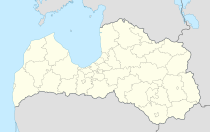Durbe
| Durbe ( German : Durben) | ||
|---|---|---|
 |
|
|
| Basic data | ||
| State : |
|
|
| Landscape: | Courland ( Latvian : Kurzeme ) | |
| Administrative district : | Durbes novads | |
| Coordinates : | 56 ° 35 ' N , 21 ° 22' E | |
| Residents : | 561 (Jan. 1, 2016) | |
| Area : | 2.5 km² | |
| Population density : | 224 inhabitants per km² | |
| Height : | ||
| City law: | since 1893 | |
| Website: | www.durbe.lv | |
| Post Code: | ||
| ISO code: | ||
| Ruins of the Durben order castle | ||
Durbe (German Durben ) is a city in western Latvia .
history
The city was first mentioned in documents in 1230. In 1260 a Lithuanian army defeated an army of the Teutonic Order near today's city in the Battle of the Durbe . The rule of the Teutonic Order over the area (since 1253) continued, however; since the first half of the 14th century, the order secured it through the Durben Castle. In the 15th century a village protected by hookwork was formed around the castle .
Since 1561 Durbe belonged to the Duchy of Courland and Zemgale . It received the status of a patch and was the seat of an official with the title "Captain". In 1651 a stone church was built to replace a church built in 1599. During the Great Northern War in 1701 the castle and a large part of the town were destroyed. With the end of the Duchy of Courland in 1795, Durbe fell to the Russian Empire .
In 1821, Count Christoph Johann von Medem had Durben Castle, which dates back to 1671, completely rebuilt according to plans by the architect Johann Gottfried Adam Berlitz.
During the First World War , Durbe was occupied by German troops in 1915. Durbe has been part of the Republic of Latvia since 1918 . Since 1929 there was a train station on the Jelgava - Liepaja line.
City rights according to the Russian city code were granted to Durbe in 1893. They were confirmed by the German military administration in 1917 and by the Republic of Latvia in 1938.
coat of arms
In 1925 Durbe was awarded the coat of arms. It features a silver apple tree, which in Latvian folklore is seen as a source of youth and compassion.
Attractions
- Evangelical church, completed in 1651, with a baroque altar and a baroque pulpit as well as an organ from 1834
- Pietà by Valdis Albergs (1924–1984) as a memorial to commemorate the victims of the deportations of Latvian citizens in 1941 and 1949 (in front of the church)
- Durben Castle
sons and daughters of the town
- Elisabeth von Grotthuss (1820–1896), Baltic German narrator and playwright
- Atis Kronvalds (1837–1875) social worker, publicist
- Zigfrīds Anna Meierovics (1887–1925), politician
Durbes novads
In 2000 the city and two surrounding communities formed the administrative unit Durbes novads. In 2009 two more congregations joined. 3401 inhabitants live in the district (as of July 1, 2010). The administrative center is located in Lieģi village.
literature
- Hans Feldmann , Heinz von zur Mühlen (ed.): Baltic historical local dictionary, part 2: Latvia (southern Livonia and Courland). Böhlau, Cologne 1990, ISBN 3-412-06889-6 , pp. 135-136.
- Astrīda Iltnere (ed.): Latvijas Pagasti, Enciklopēdija. Preses Nams, Riga 2002, ISBN 9984-00-436-8 .
Footnotes
- ↑ a b c d e f Hans Feldmann, Heinz von zur Mühlen (ed.): Baltic historical local lexicon, part 2: Latvia (southern Livland and Courland). Böhlau, Cologne 1990, p. 135.
- ^ Erwin Oberländer : The Duchy of Courland 1561–1795. Constitution, Economy, Society , Vol. 2. Verlag Nordostdeutsches Kulturwerk, Lüneburg 2001, ISBN 3-932267-33-8 , p. 82.
- ↑ Jānis Krastiņš: A Thousand Years of Neighborhood: Connections between Latvia and the Germans in the field of fine arts and architecture . In: Aina Balaško (ed.): German architects in Latvia . Latvijas Vācu Savienība, Riga 2013, ISBN 978-9984-49-671-9 , pp. 26–37, here p. 37.
- ↑ Sigurds Rusmanis, Ivars Vīks: Kurzeme . Izdevniecība Latvijas Enciklopēdija, Rīga, ISBN 5-89960-030-6 , p. 22.


